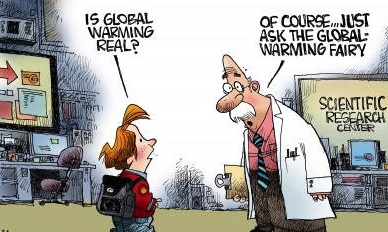by Oren Cass • City-Journal
Thirty-nine percent of Americans give at least 50-50 odds that “global warming will cause humans to become extinct,” according to a poll released last week by the Yale Program on Climate Change Communication. This extreme view, unsupported by mainstream climate science, is more widely held than the belief that climate change either is “caused mostly by natural changes in the environment” rather than human activity (30 percent), or else “isn’t happening” at all (6 percent). As if on cue, New York published a cover story on Monday entitled, “The Uninhabitable Earth,” with this grim subtitle: “Famine, economic collapse, a sun that cooks us: What climate change could wreak—sooner than you think.” David Wallace-Wells’s 7,000-word article is so disconnected from reality that debunking loses its thrill within a few paragraphs. Even Michael Mann, among the most strident climate scientists, wrote on Facebook that “Extraordinary claims require extraordinary evidence. The article fails to produce it.”
Mann notes that, in his first section alone, Wallace-Wells “exaggerates” the threat of melting permafrost, while his claim about satellite data is “just not true.” The story next intones ominously about “a crack in an ice shelf [that] grew 11 miles in six days, then kept going.” But the Guardian (no climate-change denier), covering the ice-shelf crack last month, explained it differently: “What looks like an enormous loss is just ordinary housekeeping for this part of Antarctica.”
Wallace-Wells’s article is a quintessential illustration of what I have described in Foreign Affairs as “climate catastrophism.” He ignores humanity’s capacity for adapting to changes that will occur slowly over decades or centuries, inserting the classic catastrophist disclaimer in his introduction: “absent a significant adjustment to how billions of humans conduct their lives . . .” But humanity will obviously make significant adjustments in the coming century, especially if faced with the catastrophes he posits. The qualifier undermines everything that follows, just as it did the Population Bomb and Peak Oil prognosticators of the past.
Likewise, Wallace-Wells seems not to understand that the world of future centuries will look vastly different from today’s, and that climate impacts must be understood in this context. Thus, he takes a particularly extreme warning that climate change might reduce global output 50 percent by 2100 and invites readers to “imagin[e] what the world would look like today with an economy half as big.” But the study in question is producing estimates for the world of 2100, not 2017—the loss is “relative to scenarios without climate change.” Even growing at only 2.5% annually, the global economy of 2100 would be seven times larger than today’s. Cutting that in half is a catastrophe, comparatively speaking—but still yields a dramatically wealthier world than we have today. Wallace-Wells claims to have conducted “dozens of interviews and exchanges with climatologists and researchers in related fields,” but he seemingly could not find any to go on the record validating any of his claims. He even acknowledges that the three whom he does quote—one on mitigating climate impacts, one on the history of climate science, and one on past extinctions—are all optimists about humanity’s ability to “forestall radical warming.”
The reaction among commentators to the New York article helps to explain why public attitudes tilt toward catastrophism. Farhad Manjoo, the New York Times technology writer, called it “phenomenal.” David Roberts, the Vox climate writer, deemed it “superb.” Mann was sharply critical, but nonetheless complimented Wallace-Wells as “clearly a talented” journalist. (By contrast, Mann identified no errors in my Foreign Affairs essay but called it “#Koch climate denial propaganda” and then blocked me on Twitter.)
Similarly covering criticism with endorsement, Mashable’s Andrew Freedman laments that “in several places,” Wallace-Wells “either exaggerates the evidence or gets the science flat-out wrong.” But this, in his view, is merely “unfortunate, because it detracts from a well-written, attention-grabbing piece. It’s still worth reading, but with a sharp critical eye.” At The Atlantic, Robinson Meyer reports that “at key points in his piece, Wallace-Wells posits facts that mainstream climate science cannot support” and “at other points, Wallace-Wells misstates what we know about the climate change that has already happened.” Nevertheless, writes Meyer, “this isn’t to say that his piece is worth discarding in its entirety.”
Any article that so badly mischaracterizes the state of knowledge on an issue as contentious as climate science should have been rejected for publication. New York magazine should be posting corrections, not tallying clicks.
I appeared recently on a podcast hosted by John Cook and Peter Jacobs, two specialists in “climate communication” and authors of the famous “97 percent consensus” study claiming that almost all climate scientists agree on anthropogenic global warming. I asked them whether they feel obligated to police overly catastrophic claims, or only what they call “denialism.”
“If you see it, I think it can be helpful to call out,” said Cook. “But I also think that it would be a mistake to try to do a 50-50 where you try to spend half your time debunking exaggerators and half your time debunking denial of the science because I don’t think that’s an accurate picture of what is out there in terms of distorting the science.” But if anything, today’s landscape suggests it is the exaggeration that requires the greatest attention. Scientists and journalists genuinely committed to providing the public with an accurate picture, rather than just the picture most conducive to a preferred policy agenda, have lots of work to do.

